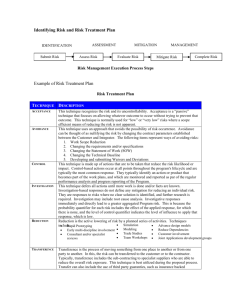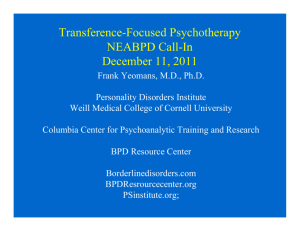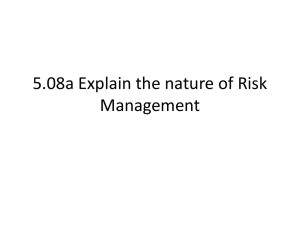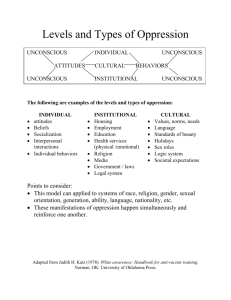Unconscious Transference - University of Northern Iowa
advertisement
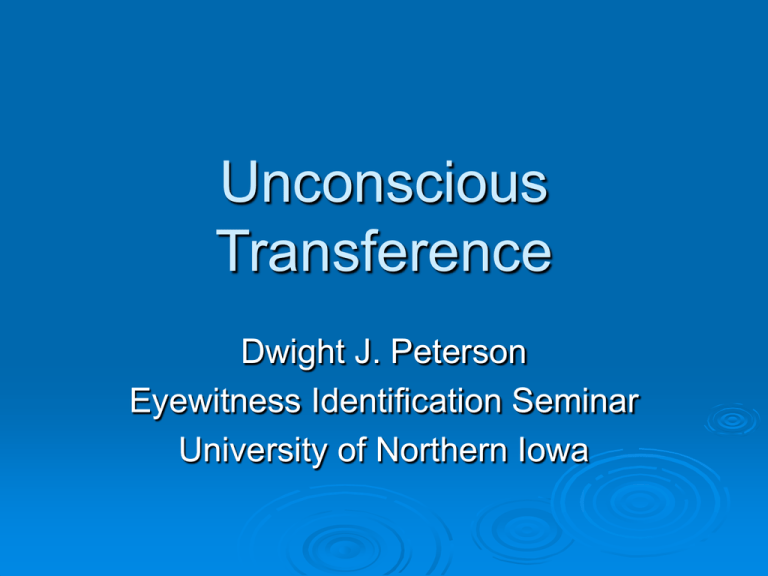
Unconscious Transference Dwight J. Peterson Eyewitness Identification Seminar University of Northern Iowa Unconscious Transference Definition: Identifying a innocent foil, who is familiar from some context, instead of the actual perpetrator Different from identifying any old foil face from the lineup? Unfortunately, yes, this phenomenon presents yet another problem with eyewitness ID’s Transference Effect Joe I see Joe steal a car Police show up I am the witness to the crime Tom Cops have no one in custody I see Tom while flipping through a mugshot book at the police station Later on, I’m given the following lineup: Transference Effect What happens if I pick number 4? What happens if number 4 (Tom) has two priors for grand theft auto? History Glanville Williams (1955) Houts (1956) The sailor and the ticket agent Elizabeth Loftus (1976) Coined the term Pioneer study of the UT effect TA lineup: 60% chose previously viewed “bystander” Thompson (1988) Rape victim confusion related to source of familiarity Associated Problems Mugshot Different context, but familiarity remains Lineups after mugshots = increased probability for misidentification Innocent books bystanders Same context, retrieve and identify innocent face from lineup Theories Source monitoring errors Distinguishing between memory sources Automatic Implicit Memory Infer processing identity at encoding or retrieval “Conscious Inference” • Read et al., (1990) Source Monitoring External Based on sensory experience and subsequent perception Internal Based on thoughts, feelings Easier to distinguish between one internal and one external memory Reality Monitoring: Harder to distinguish between two external (or two internal) memories Lindsay & Johnson (1989) Automatic Processes Remembering old non-famous names as famous Jacoby, Kelly, Brown, & Jasechko (1989) Familiarity without recognition Jacoby, Woloshyn, & Kelley (1989) Automatic processing of faces may lead to familiarity without conscious attention to features necessary for differentiation Conscious Inference Retrieval Bystander does not come into play until the lineup is presented Read et al., (1990) Encoding Ross et al., (1994) Erroneously thinking the bystander is the assailant while encoding the crime, and later thinking they are one in the same Differentiating Between Bystander and Perpetrator One in the same? TA-lineups increase transference Lineups with BOTH the bystander and perpetrator cause a different type of trouble for transference participants Awareness that the two are DIFFERENT decreases transference • Ross et al., (1994) (Experiment 2) • Phillips, Geiselman, Haghighi, & Lin (1997) Evidence for Unconscious Transference Loftus (1976) Read et al., (1990); Experiment 5 View conscious inference as occuring at retrieval Ross et al., (1994); Experiments 1, 2, 3, 4 Evidence for conscious inference at encoding Experiments 3 & 4 manipulated encoding Found conscious inference was made soon after viewing the portion of video displaying the crime Meta-analysis Deffenbacher, Bornstein, & Penrod (2006) Mainly a review of problems with mugshots Commitment effects Retroactive Interference Unconscious Transference • Effect size twice as large for studies looking at the mugshot exposure compared to studies looking at exposure to an innocent bystander Memory and Mugshot Books Commitment effects pose a problem Dysart, Lindsay, Hammond, & Dupuis (2001) • Found greater inaccuracy rates for commitment group (Experiment 2) • No difference between control conditions and transference conditions (Experiment 2) Other Related Issues Older participants Higher misidentification rates for younger facial stimuli More errors related to identity confusion for older participants • Perfect & Harris (2003) Other-race faces and context memory More errors for which context (background) a face was observed for African American faces • Horry & Wright (2008) A Recent Theory Unconscious transference as a type of change blindness? Davis, Loftus, Vanous, & Cucciare, (2008) Illusions of continuity Levin & Simons (2000) Continuous vs. Discontinuous Innocent Misidentification rates higher for the CI What do you think? Is the evidence for unconscious transference compelling enough to attempt policy suggestions or even worthy of mention in court by expert witnesses? Does talking about this phenomenon decrease the credibility of the expert witness? What about Kassin, et al’s (2001) position on reliable evidence? Thank You! Any comments or constructive criticism you may have regarding this presentation would be greatly appreciated! References Davis, D., Loftus, E. F., Vanous, S., & Cucciare, M. (2008). ‘Unconscious transference’ can be an instance of ‘change blindness.’ Applied Cognitive Psychology, 22, 605-623. Deffenbacher, K. A., Bornstein, B. H., & Penrod, S. D. (2006). Mugshot exposure effects: Retroactive interference, mugshot commitment, source confusion, and unconscious transference. Law and Human Behavior, 30, 287-307. Dysart, J. E., Lindsay, R. C. L., Hammond, R., & Dupuis, P. (2001). Mugshot exposure prior to lineup identification: Interference, transference, and commitment effects. Journal of Applied Psychology, 86, 12801284. Geiselman, R. E., Haghighi, R., & Stown, Ronna (1996). Unconscious transference and characteristics of accurate and inaccurate eyewitnesses. Psychology, Crime, and Law, 2, 197-209. Horry, R., & Wright, D. B. (2008). I know your face but not where I saw you: Context memory is impaired for other-race faces. Psychonomic Bulletin & Review, 15, 610-614. Kassin, S. M., Tubb, V. A., Hosch, H. M., & Memon, A. (2001). On the “general acceptance” of eyewitness testimony research. American Psychologist, 56, 405-416. Loftus, E. F. (1976). Unconscious transference in eyewitness identification. Law and Psychology Review, 2, 93-98. Perfect, T. J., & Harris, L. J. (2003). Adult age differences in unconscious transference: Source confusion or identity blending? Memory & Cognition, 31, 570-580. Phillips, M. R., Geiselman, R. E., Haghighi, D., & Lin, C. (1997). Some boundary conditions for bystander misidentifications. Criminal Justice and Behavior, 24, 370-390. Read, D. J., Tollestrup, P., Hammersley, R., McFadzen, E., et al. (1990). The unconscious transference effect: Are innocent bystanders ever misidentified? Applied Cognitive Psychology, 4, 3-31. Ross, D. F., Ceci, S. J., Dunning, D., & Toglia, M. P. (1994). Unconscious transference and mistaken identity: When a witness misidentifies a familiar but innocent person. Journal of Applied Psychology, 79, 918-930.
